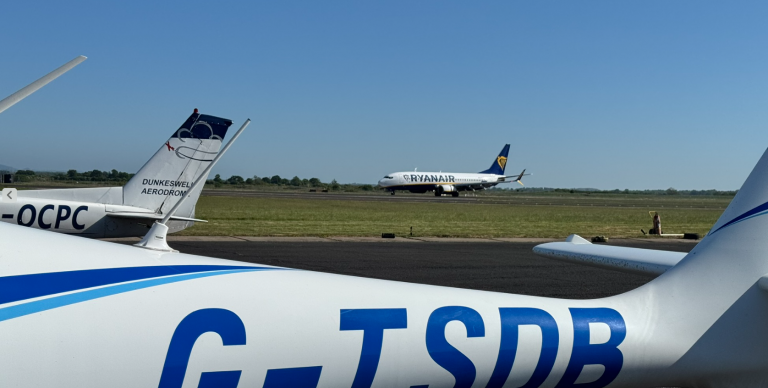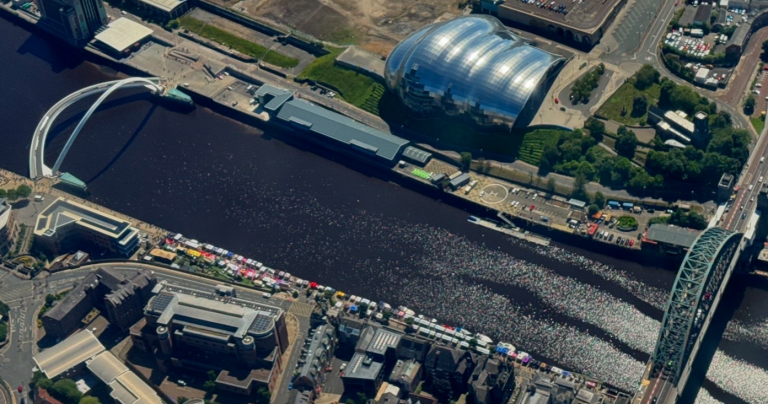After my ego (and nerves!) had taken a comprehensive battering at the previous lesson my mindset had shifted from “I’m here to show the instructor I already know what I’m doing” to “I’m here to learn”. For any students out there, as soon as you stop learning you’re in trouble.
We briefed quickly at the newly renovated clubhouse in the cool room with the Spitfire-decorated smoked glass walls: we’ll tackle base-to-final stalls today, then approach configuration stalls, then maybe some circuits.
Checklists
I was being quite quick and efficient with the external checks when a family doing a ‘discovery’ flight walked over with their pilot. As I zipped around with a stepladder checking linkages, draining samples of fuel, dipping oil and doing flight control tests I imagined I probably looked like I knew what I was doing to them, and it made me realise that – despite the cock ups – I had made quite a lot of progress since taking that Cessna 172 into the air for the first time just under a year ago.
With the plane confirmed to be in good condition, the instructor and I climbed on board, I started the engine, radio’d the AGCS frequency of our intentions and taxiied down to our holding point at Charlie.
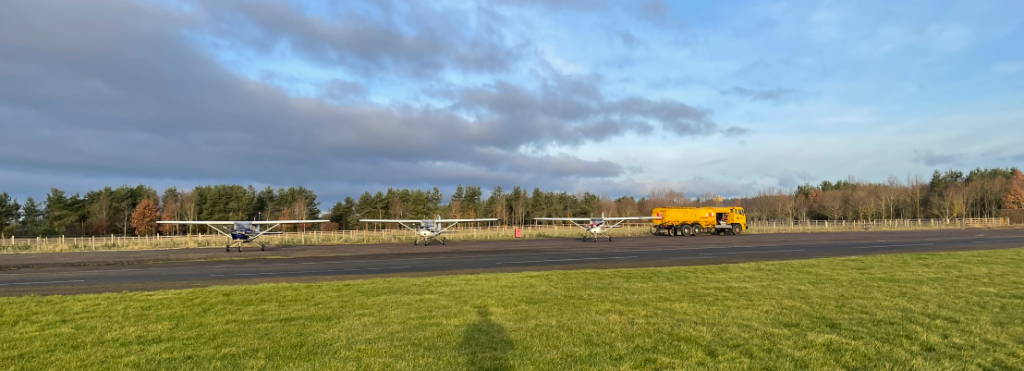
Stalling
Once in the air, taking care not to drift too much off the extended centre-line of the runway after take off, we turned left again, crossing the deadside, and headed out up towards Coquet Island off the Northumberland port town of Amble and climbed to 3,000ft.
Passing Warkworth, level at 3,000ft I started the HASELL checks for our stalls:
- H – Height, adequate for recovery. This should be a minimum of 2,000ft above the ground and at 3,000ft over the coast we had a 50% margin for error. Check!
- A – Airframe, the aircraft was in a clean configuration as expected and we’d be configuring as if preparing to land shortly. Check!
- S – Security – anything that might move around in the cabin was safely tidied away, our seatbelts were fastened and doors were securely shut. Check!
- E – Engine – temperature and pressures all in the green, suction and ammeter within limits and checking for carb icing. Check!
- L – Location – Using the AABCD mnemonic we checked we weren’t near Active airfields, Built-up areas, Clouds, Controlled airspace or Danger/restricted areas. Check!
- L – Lookout – we performed either 2x 90-degree turns or a single 180-degree turn to ensure there was no air traffic around us. Check!
We went straight into the lesson with me hoping that some of the muscle memory from flight sim would stick.
I configured for landing – carb heat, 1500rpm, with air speed in the white arc I extended the flaps, and then started a turn to simulate base to final in the pattern, pulling back on the controls as if desperate to not overshoot the extended centreline. The nose went up and up rather than sliding sideways like it had in the previous lesson keeping our airspeed frustratingly within the flight envelope. This time the airspeed bled off and my instructor did his stall warning horn impression again. “Beep!”
I released the pressure on the controls in my left hand and the nose dropped, then I firewalled the throttle and immediately closed the carb heat in a fast one-two motion with my right hand. Somewhere in between operating the throttle and carb heat I rolled the wings level and at 60 knots on the airspeed indicator I started the climb. We’d lost around 50 feet of altitude so we busted through 3,000ft whist practising the climb out from a 500ft base-to-final turn, raising the flaps in stages.
“That was much better than last time. Let’s do it one more time to be sure.”
With a clean-configured aircraft once again I descended to 3,000ft while doing two 90 degree clearing turns and then reconfigured quickly but not rushing. I wanted to be at 3,000ft because it was a nice round number that we could use to easily see how much altitude we were losing in the stall.
Carb heat, 1500rpm, flaps out when in the white arc, and started a turn onto final.
“Beep!”
Control column forward then wings level with the left hand while pushing the throttle to full power and closing the carb heat with the right. The muscle memory was definitely there. I realised once we were in the climb that I didn’t even look inside the cockpit this time – my eyes were glued to the windows, looking for traffic outside.
“Great job, we can check that off the list. Now we’ll do a final approach stall, same configuration just without the turn.”
Carb heat, 1500rpm, flaps out, started a gentle descent as if on final approach.
“Look at that A380 taking off ahead of us!” Roleplayed the instructor jokingly. “Let your eyes follow it up.”
I arrested the descent rate and started a shallow climb. To maintain level flight in a cleanly configured C150 at cruise speeds you need the engine set to 2,350rpm, so at 1,500rpm and two 6ft long Fowler flap panels hanging into the airflow causing serious drag, we slowed down very quickly.
“Beep!”
The control column went forward, power in – one!, carb heat in – two!, 60kts, climb, flaps up in stages. Within just a few seconds we were back at 3,000ft with a clean machine.
“Yeah, no problems there at all. Have you done circuits before?”
I said I had.
“Let’s get some circuits in before the end of the lesson, do you want to take us back to the airfield?”
I nodded, turning us towards the south and a group of wind turbines I used as a visual reference point for the airfield. “Eshott radio, Golf-Alpha-Sierra-Zulu-Uniform 2 miles north of Amble inbound for standard overhead join.”
“Nice!” said the instructor.
Once the airfield was in sight I saw the windsock was pointing almost exactly between the two runways. “Looks like wind is from 220 degrees,” I said. Our runways point 190 degrees and 250 degrees it was a coin toss which one we’d use but the decision was made for us.
“… final runway one-niner,” said another pilot. Traffic already in the pattern dictates the active runway, so runway 19 it was.
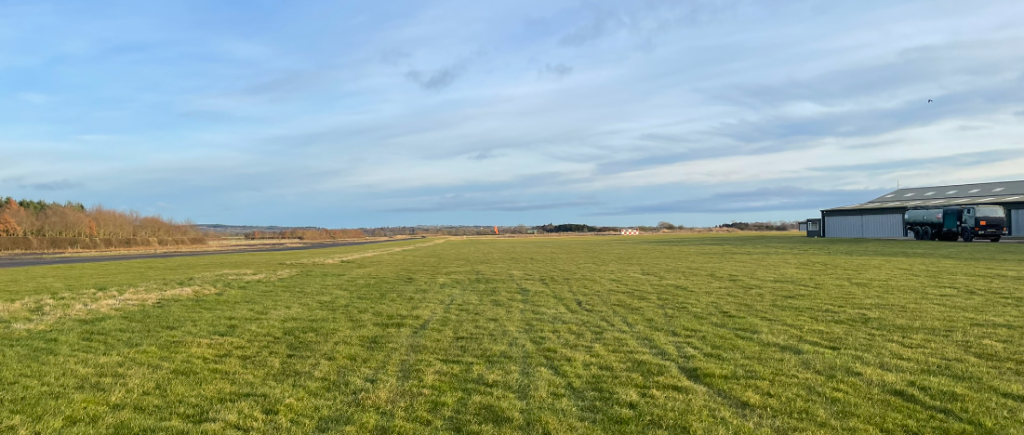
Runway 19G (grass) also visible to the right of 19 hard as the strip of mown grass.
I turned to parallel runway 19 at 1,500ft above the ground and started to descend to pattern height. “Golf Zulu Uniform descending deadside runway 19.”
The instructor and I watched the landing traffic slow down and pull off the runway to the parking area. At 1,000ft above airfield level (aal) I turned across the runway extended centreline onto crosswind, keeping the nose pointed slightly towards the south to counter-act the drift from the wind.
As I turned north onto downwind I pushed the radio button again, “Golf-Zulu-Uniform downwind runway 19,” and ran the downwind checks.
5 & 1/2 landings
With the 19 runway numbers in our right window (right hand circuit), I started to configure for landing. Again, after practicing base to final stalls this was a bit weird. Carb heat, 1500rpm, white arc, flaps, pitch and trim for 60 knots.
At 800ft, we lined up with a bridge which carried the A1 carriageway over the River Coquet which we use as a visual reference point to turn onto base. With the gorgeous Northumberland village of Felton in our windscreen I waited until we were at 500ft and turned onto final – making sure not to stall!
Fighting with a bit of a crosswind I brought the little Cessna down the glideslope to 50ft, reduced power to idle and then floated down the runway, touching down a couple of hundred feet after the threshold with a little bump.
“OK, let’s stop and backtrack,” said the instructor, indicating that I’d been too greedy on the touchdown to do a touch-and-go. I swung Zulu-Uniform around and backtracked back to Charlie whilst doing a radio call.
“Taking off runway 19,” I said over the radio as we didn’t waste any time getting back into the air. Once on downwind we noticed the wind was really picking up from the west, bringing a wall of dark clouds our way. I configured again for landing, followed the same procedures as before – 800ft onto base, 500ft onto final, and again brought the Cessna down the approach path. This time I reduced power a little quickly and the left-yawing moment caught me a bit by surprise, exacerbated by the crosswind I was already trying to correct for. I corrected further and landed with another bump but on the centreline.
“Full power,” said the instructor, and I took her back into the sky.
On our fifth time around the circuit the wind was even stronger, I was pointing the nose 20 degrees to the left just to go straight on downwind.
I configured for landing, turned onto base, then onto final. The approach profile was good, despite the nose being off to the right now and the runway practically being in the side window. At 200ft my instructor surprised me. “Go around.”
I clumsily pushed in the power, added right rudder to control the yaw, and pointed the nose up.
“Carb heat,” said the instructor. I pushed it in. “It probably won’t kill you but you really want all that engine power.”
With the wind sock fully horizontal and perpendicular to runway 19 indicating a greater than 15 knot (17mph) crosswind, we opted to switch runways to runway 25 (nee 26). “Golf Zulu Uniform going around, switching runways to 25,” the instructor radio’d on the AGCS frequency.
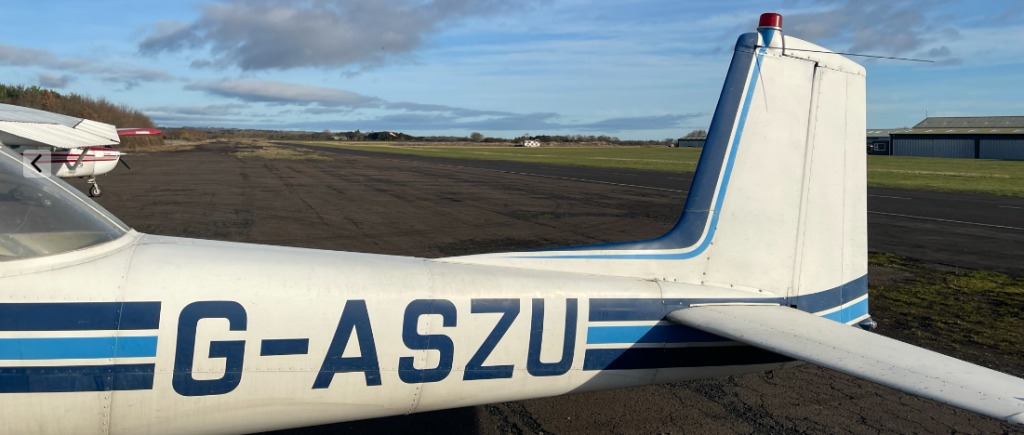
I turned left onto left downwind for runway 25, then onto base. Runway 25 has a longer base leg than 19 so I waited until almost turning final before setting up for landing. Carb heat, 1500rpm, white arc, flaps, pitch and trim for 60kts.
I thought we looked really high but the instructor explained that with a strong headwind you want to look high because you actually have more air (i.e. the wind) to descend through than normal and he was right. At 100ft above the ground I was nicely lined up with the runway and looking down the runway to stay lined up.
Evasive Action
“What the…! I have control,” said the instructor, grabbing the controls and swinging the aircraft hard to the left in what felt like a handbrake turn.
As we turned I noticed right in front of us was a hay bale. Not on the ground, but 50 feet in the air in our path. Attached to the bale was a fork lift crane at full boom extension. I had completely missed it as my focus was down the runway. If I’d been on a solo flight I’d likely be dead now.
We were able to salvage the approach and landed on the numbers but feeling a bit shaken up with some serious questions to ask of the farmer next door.
We taxiied back to parking, ran the shut-down checklists, took a quick selfie (below) and had the debrief on the walk back to the clubhouse.


